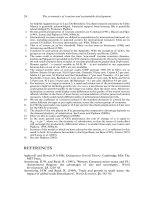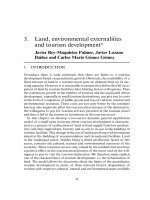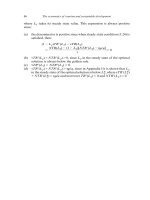THE ECONOMICS OF MONEY,BANKING, AND FINANCIAL MARKETS 157
Bạn đang xem bản rút gọn của tài liệu. Xem và tải ngay bản đầy đủ của tài liệu tại đây (30.35 KB, 1 trang )
CHAPTER 6
The Risk and Term Structure of Interest Rates
125
Thus
i 5t *
5% + 6% + 7% + 8% + 9%
* 7.0%
5
Using the same equation for the one-, three-, and four-year interest rates, you
will be able to verify the one-year to five-year rates as 5.0%, 5.5%, 6.0%, 6.5%, and
7.0%, respectively. The rising trend in short-term interest rates produces an
upward-sloping yield curve along which interest rates rise as maturity lengthens.
The expectations theory is an elegant theory that explains why the term structure of interest rates (as represented by yield curves) changes at different times.
When the yield curve is upward-sloping, the expectations theory suggests that
short-term interest rates are expected to rise in the future, as we have seen in our
numerical example. In this situation, in which the long-term rate is currently above
the short-term rate, the average of future short-term rates is expected to be higher
than the current short-term rate, which can occur only if short-term interest rates
are expected to rise. This is what we see in our numerical example. When the yield
curve is inverted (slopes downward), the average of future short-term interest rates
is expected to be below the current short-term rate, implying that short-term interest rates are expected to fall, on average, in the future. Only when the yield curve
is flat does the expectations theory suggest that short-term interest rates are not
expected to change, on average, in the future.
The expectations theory also explains fact 1, that interest rates on bonds with
different maturities move together over time. Historically, short-term interest rates
have had the characteristic that if they increase today, they will tend to be higher
in the future. Hence, a rise in short-term rates will raise people s expectations of
future short-term rates. Because long-term rates are the average of expected future
short-term rates, a rise in short-term rates will also raise long-term rates, causing
short- and long-term rates to move together.
The expectations theory also explains fact 2, that yield curves tend to have an
upward slope when short-term interest rates are low and are inverted when shortterm rates are high. When short-term rates are low, people generally expect them
to rise to some normal level in the future, and the average of future expected
short-term rates is high relative to the current short-term rate. Therefore, longterm interest rates will be substantially above current short-term rates, and the
yield curve would then have an upward slope. Conversely, if short-term rates are
high, people usually expect them to come back down. Long-term rates would
then drop below short-term rates because the average of expected future shortterm rates would be below current short-term rates and the yield curve would
slope downward and become inverted.2
2
The expectations theory explains another important fact about the relationship between short-term
and long-term interest rates. As you can see looking back at Figure 6-4, short-term interest rates are
more volatile than long-term rates. If interest rates are mean-reverting that is, if they tend to head
back down after they are at unusually high levels or go back up when they are at unusually low
levels then an average of these short-term rates must necessarily have lower volatility than the
short-term rates themselves. Because the expectations theory suggests that the long-term rate will
be an average of future short-term rates, it implies that the long-term rate will have lower volatility
than short-term rates.









